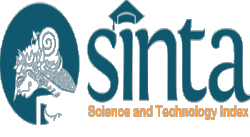Does maturity signals high risk and high return?
Abstract
The objective of this study is to examine the interaction between firm maturity and firm growth opportunities over risk and its impact on returns. This study uses 135 firms listed in Indonesia Stock Exchange during 2010 to 2016 as sample which gives 945 as total observed data. This study conducts path analysis in term for hypothesis testing and finds that firm maturity has significant role to increase the risk which gives impact on increasing the returns. In context of Indonesian firms, the findings imply that mature firms will have higher risk and higher returns.
Keywords
Full Text:
PDFReferences
Asquith, P., & Mullins, D. W. (1986). Signalling with dividends, stock repurchases, and equity issues. Financial Management, 15(3), 27-44. http://www.jstor.org/stable/3664842
Ben-Horim, M., & Levy, H. (1980). Total risk, diversifiable risk and nondiversifiable risk: A pedagogic note. The Journal of Financial and Quantitative Analysis, 15(2), 289-297. https://doi.org/10.2307/2330346
Bernardo, A. E., Chowdhry, B., & Goyal, A. (2007). Growth options, beta, and the cost of capital. Financial Management, 36(2), 1-13. https://doi.org/10.1111/j.1755-053X.2007.tb00084.x
Bollerslev, T., & Zhang, B. Y. B. (2003). Measuring and modeling systematic risk in factor pricing models using high-frequency data. Journal of Empirical Finance, 10, 533-558. https://doi.org/10.1016/S0927-5398(03)00004-5
Budiarso, N. S., Subroto, B., T, Sutrisno., & Pontoh, W. (2019). Dividend catering, life-cycle, and policy: Evidence from Indonesia. Cogent Economics & Finance, 7(1). https://doi.org/10.1080/23322039.2019.1594505
Connelly, B. L., Certo, S. T., Ireland, R. D., & Reutzel, C. R. (2011). Signaling theory: A review and assessment. Journal of Management, 37(1), 39–67. https://doi.org/10.1177/0149206310388419
DeAngelo, H., DeAngelo, L., & Stulz, R. M. (2006). Dividend policy and the earned/contributed capital mix: a test of the life-cycle theory. Journal of Financial Economics, 81(2), 227–254. https://doi.org/10.1016/j.jfineco.2005.07.005
Easterbrook, F. H. (1984). Two agency-cost explanations of dividends. The American Economic Review, 74(4), 650-659. http://www.jstor.org/stable/1805130
Fairchild, R., Guney, Y., & Thanatawee, Y. (2014). Corporate dividend policy in Thailand : Theory and evidence. International Review of Financial Analysis, 31, 129-151. https://doi.org/10.1016/j.irfa.2013.10.006
Fama, E. F., & French, K. R. (1992). The cross‐section of expected stock returns. The Journal of Finance, 47(2), 427-465. https://doi.org/10.2307/2329112
Fama, E. F., & French, K. R. (1993). Common risk factors in the returns on stocks and bonds. Journal of Financial Economics, 33(1), 3-56. https://doi.org/10.1016/0304-405X(93)90023-5
Fama E. F., & French K. R. (2001). Disappearing dividends: changing firm characteristics or lower propensity to pay? Journal of Financial Economics, 60(1), 3–43. https://doi.org/10.1016/S0304-405X(01)00038-1
Frazzini, A., & Pedersen, L. H. (2014). Betting against beta. Journal of Financial Economics 111(1), 1-25. http://dx.doi.org/10.1016/j.jfineco.2013.10.005
Grullon, G., Michaely, R., & Swaminathan, B. (2002). Are Dividend Changes a Sign of Firm Maturity? The Journal of Business, 75(3), 387-424. http://doi.org/10.1086/339889
Gulec, O. F., & Karacaer, S. (2017). Corporate life cycle methods in emerging markets: Evidence from Turkey. Journal of Economics, Finance and Accounting, 4(3), 224-236. http://doi.org/10.17261/Pressacademia.2017.690
Lakonishok, J., & Shapiro, A. C. (1986). Systematic risk, total risk and size as determinants of stock market returns. Journal of Banking and Finance, 10(1), 115–132. https://doi.org/10.1016/0378-4266(86)90023-3
Lewis, C. M., Rogalski, R. J., & Seward, J. K. (2003). Industry conditions, growth opportunities and market reactions to convertible debt financing decisions. Journal of Banking and Finance, 27(1), 153–181. https://doi.org/10.1016/S0378-4266(01)00212-6
R.A., D., & Rahmanti, W. (2013). Return dan risiko saham pada perusahaan perata laba dan bukan perata laba. Jurnal Dinamika Akuntansi, 5(1). https://doi.org/10.15294/jda.v5i1.2563
Ross, S. (1977). The Determination of financial structure: The incentive-signalling approach. The Bell Journal of Economics, 8(1), 23-40. https://doi.org/10.2307/3003485
Teh, K., & Lau, W. (2017). The dual-beta model: Evidence from the Malaysian Stock Market. Indonesian Capital Market Review, 9(1), 39-52. https://doi.org/10.21002/icmr.v9i1.6367
Weitzman, M. L. (2013). Tail-hedge discounting and the social cost of carbon. Journal of Economic Literature, 51(3), 873-882. http://dx.doi.org/10.1257/jel.51.3.873
DOI: https://doi.org/10.32400/iaj.25404
Refbacks
- Garuda Ristekdikti
- Microsoft Academic
- Dimensions
- Openaire
- Google Scholar
- Scinapse
- SDM Universitas Sam Ratulangi
- Base
- Directory of Open Access Journals (DOAJ)
- Neliti
- Researchgate
- Scilit
Copyright (c) 2019 Novi Swandari Budiarso, Winston Pontoh

This work is licensed under a Creative Commons Attribution 4.0 International License.
Publisher:
Program Studi Pendidikan Profesi Akuntansi
Fakultas Ekonomi dan Bisnis
Universitas Sam Ratulangi
Jl. Kampus Bahu - Manado, Sulawesi Utara
Indonesia 95115
Cooperation with:
Ikatan Sarjana Ekonomi Indonesia (ISEI)
d/a. Sekretariat Ikatan Sarjana Ekonomi
Fakultas Ekonomi dan Bisnis Universitas Sam Ratulangi
Jl. Kampus Bahu - Manado, Sulawesi Utara
Indonesia 95115














1.png)
